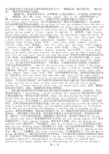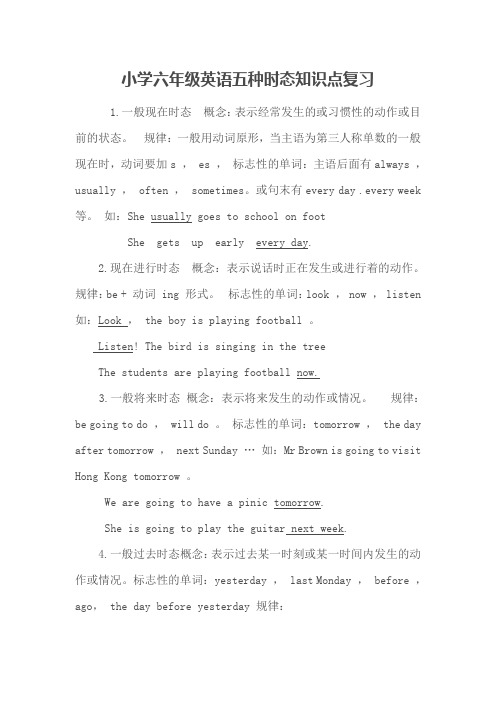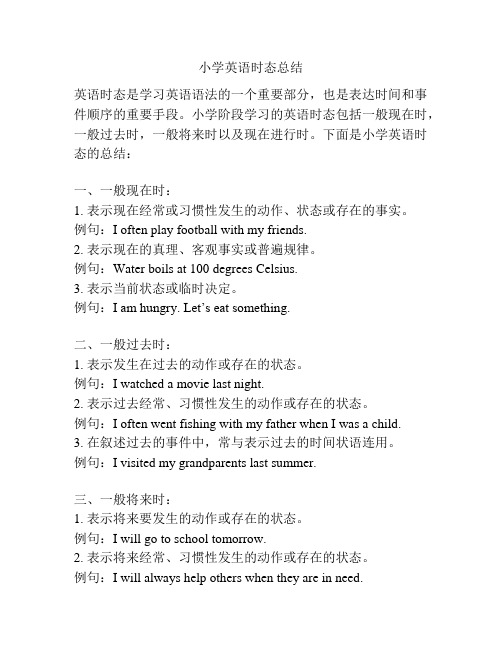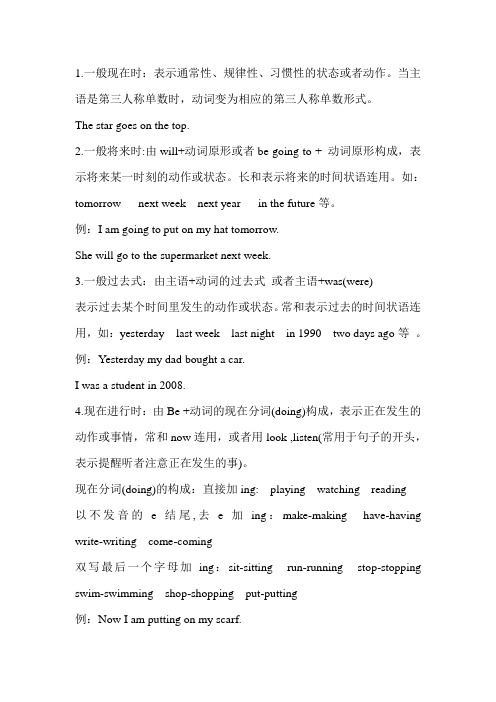小学英语五大时态
小学英语中五大语法时态详解

小学英语中五大语法时态详解在小学英语学习中,掌握语法时态是非常重要的一部分。
正确运用时态可以帮助我们准确表达过去、现在和将来的事情。
下面将详细介绍小学英语中的五大语法时态。
一、一般现在时(Simple Present Tense)一般现在时用于描述经常发生的动作、事实或习惯。
它的构成非常简单,一般情况下只需在动词原形后加上“s”或“es”。
例如:1. I eat an apple every day.(我每天吃一个苹果。
)2. She goes to school by bus.(她乘公交车去学校。
)二、一般过去时(Simple Past Tense)一般过去时用于描述过去发生的动作或状态。
大部分动词的过去式是在动词原形后加上“ed”。
例如:1. We played soccer yesterday.(我们昨天踢足球。
)2. He watched a movie last night.(他昨晚看了一部电影。
)三、一般将来时(Simple Future Tense)一般将来时用于描述将来要发生的动作或事件。
它的构成通常是在动词前加上“will”。
例如:1. I will visit my grandparents next week.(下周我将去拜访我的祖父母。
)2. She will learn to play the piano in the future.(她将来会学弹钢琴。
)四、现在进行时(Present Continuous Tense)现在进行时用于描述正在进行的动作。
它的构成是“be动词+动词的现在分词”。
例如:1. They are playing basketball in the park.(他们正在公园里打篮球。
)2. I am studying for the exam.(我正在备考考试。
)五、过去进行时(Past Continuous Tense)过去进行时用于描述过去某个时间正在进行的动作。
小学英语时态总结

小学英语时态总结时态是语法体系中的重要组成部分,对于学习英语的学生来说尤为重要。
在小学阶段,学生们初步学习了一些基本的英语时态,包括现在时、过去时和将来时。
下面我将总结小学英语时态的相关内容。
一、现在时态现在时态主要表示目前正在进行的动作或状态,常见的有简单现在时和现在进行时。
1. 简单现在时简单现在时用来表示经常发生的动作、真理性的陈述、习惯性的行为、常规和计划等。
肯定句结构:主语 + 动词原形 + 其他例句:I go to school every day.(我每天上学。
)She likes playing basketball.(她喜欢打篮球。
)否定句结构:主语 + do/does + not + 动词原形 + 其他例句:I do not play football.(我不踢足球。
)She does not like swimming.(她不喜欢游泳。
)一般疑问句结构:Do/Does + 主语 + 动词原形 + 其他例句:Do you like ice cream?(你喜欢冰淇淋吗?)第1页/共6页Does he go to the park?(他去公园吗?)2. 现在进行时现在进行时表示目前正在进行的动作。
肯定句结构:主语 + am/is/are + 动词-ing + 其他例句:I am watching TV now.(我正在看电视。
)They are playing soccer.(他们正在踢足球。
)否定句结构:主语 + am/is/are + not + 动词-ing + 其他例句:I am not reading a book.(我没有在读书。
)She is not studying.(她没有在学习。
)一般疑问句结构:Am/Is/Are + 主语 + 动词-ing + 其他例句:Are you eating lunch?(你在吃午饭吗?)Is he playing the piano?(他在弹钢琴吗?)二、过去时态过去时态主要表示过去发生的动作或状态,常见的有简单过去时和过去进行时。
英语五大时态句子结构

英语的五大时态包括现在时、过去时、将来时、现在完成时和过去完成时。
以下是这五大时态的句子结构:
1. 现在时:主语 + 动词 + 其他成分。
例如:I eat an apple every day.(我每天吃一个苹果。
)
2. 过去时:主语 + 动词的过去式 + 其他成分。
例如:She walked to the park yesterday.(她昨天走到公园。
)
3. 将来时:主语 + will + 动词原形 + 其他成分。
例如:He will go to school tomorrow.(他明天将会去上学。
)
4. 现在完成时:主语 + have/has + 动词的过去分词 + 其他成分。
例如:I have finished my homework.(我已经完成了我的作业。
)
5. 过去完成时:主语 + had + 动词的过去分词 + 其他成分。
例如:She had eaten her dinner before coming to the party.(她在来参加聚会之前已经吃过晚饭了。
)
需要注意的是,五大时态的句子结构并不是固定不变的,它们会根据语境和表达的需要而有所变化。
小学英语五大时态

小学英语五大时态一、一般现在时:1.概念:经常、反复发生的动作或行为及现在的某种状况。
2.时间状语:always, usually, often, sometimes, every week on sunday,3.基本结构:主语+动词原形eg:I make a snowman.主语第三人称+does She goes to school on foot. 4.否定形式:主语+ don't +动词原形I don't like washing.主语第三人称+ doesn't +动词原形She doesn't like me.5.一般疑问句:Do +主语+动词原形Do you like some breadDoes+主语第三人称+动词原形Does she go to the park二、一般过去时:1.概念:过去某个时间里发生的动作或状态;过去习惯性、经常性的动作、行为。
2.时间状语:ago, yesterday, just now, at the age of 5, one day, long long ago3.基本结构:be动词+doing eg: I finished my homework yesterday.4.否定形式:didn't +动词原型I did not finish my homework yesterday.5.一般疑问句:Did +动词原型Did you finish your homework yesterday三、现在进行时:1.概念:表示现阶段或说话时正在进行的动作及行为。
2.时间状语:now, at this time, these days, etc.3.基本结构:am/is/are+doing eg: He is doing well in his lessons.4.否定形式:am/is/are+not+doing. I am not playing .5.一般疑问句:把be动词放于句首。
英文最基本的五个时态

一、 一般现在时:用动词原型表示,但单数第三人称后要加-s,在词尾加-s时要注意:1. 一般情况:加-s 例:reads,writes,says2. 以s,x,ch,sh收尾的词加-es 例:teaches,washes,guesses3. 以辅音字母+y结尾的词变y为i再加-es 例:try--tries,carry--carries。这个时态的疑问句一般以句首加助动词do,does构成。句中动词要用原型动词be提前:do you know it?are you students?does she have a pen?1.一般现在时表示经常性或习惯性的动作:we always care for each other and help each other。they cycle to work every day。2.现在的特征或状态:he loves sports。do you sing?a little。i major in english。3. 遍真理:light travels faster than sound。two and four makes six。the moon moves round the earth。有些表示状态和感觉的动词常常可用于一般现在时:be,love,like,hate,want,hope,need,prefer,wish,know,understand,remember,believe,recognize,guess,suppose,mean,belong,think(以为),feel,envy,doubt,remain,consist,contain,seem,look(看起来),see,fit,suit,owe,own,hear,find,suggest,propose,allow,show(说明),prove,mind(在意),have(有),sound(听起来),taste(尝起来),matter,require,possess,desire等等。i feel a sharp pain in my chest。the soup contains too much salt。you see what i mean?the coat fits you very well。how do you find the book?有些表示动作的动词间或可用于这一时态,表示现刻的动作,由于动作持续时间机短,用于进行时不自然:i send you my best wishes。i salute your courage。now i extend my heartfelt thanks to you。在口语中这个时态用来表示一个按规定、计划或安排发生的情况(这是都有一个表示未来时间的状语):when do the train leave(stop at jinan)?the plane take off at 11 am。tomorrow is saturday。is there a firm on tonight?但这只限少数动词,如begin,come,go,leave,sail,start,arrive,return,dine,end,stop,depart,open,close,be等。另外,在时间或条件从句中,将来动作或状态多用这一时态表示:tell her about that when she come。turn off the light before you leave。we'll start as soon as you are ready。在口语中,这个时态间或可以用来表示一个已经发生的动作(这个动作发生的时间在说话人脑中处于很不重要的地位):they say xiao wu is back。is that true?xiao yu tells me you're going abroad。oh,i forget where he lives。yes,you answer quite well。此外一般现在时还多用于报刊、电影、电视解说等其他几种情况。
小学六年级英语上册英语五种时态知识点复习

小学六年级英语五种时态知识点复习1.一般现在时态概念:表示经常发生的或习惯性的动作或目前的状态。
规律:一般用动词原形,当主语为第三人称单数的一般现在时,动词要加s , es ,标志性的单词:主语后面有always ,usually , often , sometimes。
或句末有every day .every week 等。
如:She usually goes to school on footShe gets up early every day.2.现在进行时态概念:表示说话时正在发生或进行着的动作。
规律:be + 动词 ing 形式。
标志性的单词:look , now , listen 如:Look , the boy is playing football 。
Listen! The bird is singing in the treeThe students are playing football now.3.一般将来时态概念:表示将来发生的动作或情况。
规律:be going to do , will do 。
标志性的单词:tomorrow , the day after tomorrow , next Sunday …如:Mr Brown is going to visit Hong Kong tomorrow 。
We are going to have a pinic tomorrow.She is going to play the guitar next week.4.一般过去时态概念:表示过去某一时刻或某一时间内发生的动作或情况。
标志性的单词:yesterday , last Monday , before ,ago, the day before yesterday 规律:(1)一般情况动词后面加ed ; 如:worked , cleaned ,washed ,(2)以不发音e结尾的动词加d就要以了; 如:lived , moved ,loved(3)以辅音加y结尾的动词把y改成i再加ed ; 如:study–studied , carry—carried(4)重读闭音节的动词要双写末尾的辅音字母再加ed; 如:stop —stopped shop—shopped skip--- skipped(5)特殊变化:见不规则动词表。
小学英语时态总结

小学英语时态总结英语时态是学习英语语法的一个重要部分,也是表达时间和事件顺序的重要手段。
小学阶段学习的英语时态包括一般现在时,一般过去时,一般将来时以及现在进行时。
下面是小学英语时态的总结:一、一般现在时:1. 表示现在经常或习惯性发生的动作、状态或存在的事实。
例句:I often play football with my friends.2. 表示现在的真理、客观事实或普遍规律。
例句:Water boils at 100 degrees Celsius.3. 表示当前状态或临时决定。
例句:I am hungry. Let’s eat something.二、一般过去时:1. 表示发生在过去的动作或存在的状态。
例句:I watched a movie last night.2. 表示过去经常、习惯性发生的动作或存在的状态。
例句:I often went fishing with my father when I was a child.3. 在叙述过去的事件中,常与表示过去的时间状语连用。
例句:I visited my grandparents last summer.三、一般将来时:1. 表示将来要发生的动作或存在的状态。
例句:I will go to school tomorrow.2. 表示将来经常、习惯性发生的动作或存在的状态。
例句:I will always help others when they are in need.3. 在表示将来的时间状语后,可以用一般现在时代替一般将来时。
例句:I am going to the park this afternoon.四、现在进行时:1. 表示现在正在进行的动作。
例句:I am reading a book at the moment.2. 表示计划或安排好的未来动作或行程。
例句:I am going to the supermarket this afternoon.3. 用于表示临时状态或权宜之计。
小学英语时态总结

1.一般现在时:表示通常性、规律性、习惯性的状态或者动作。
当主语是第三人称单数时,动词变为相应的第三人称单数形式。
The star goes on the top.2.一般将来时:由will+动词原形或者be going to + 动词原形构成,表示将来某一时刻的动作或状态。
长和表示将来的时间状语连用。
如:tomorrow next week next year in the future等。
例:I am going to put on my hat tomorrow.She will go to the supermarket next week.3.一般过去式:由主语+动词的过去式或者主语+was(were)表示过去某个时间里发生的动作或状态。
常和表示过去的时间状语连用,如:yesterday last week last night in 1990 two days ago等。
例:Yesterday my dad bought a car.I was a student in 2008.4.现在进行时:由Be +动词的现在分词(doing)构成,表示正在发生的动作或事情,常和now连用,或者用look ,listen(常用于句子的开头,表示提醒听者注意正在发生的事)。
现在分词(doing)的构成:直接加ing: playing watching reading以不发音的e结尾,去e加ing:make-making have-having write-writing come-coming双写最后一个字母加ing:sit-sitting run-running stop-stopping swim-swimming shop-shopping put-putting例:Now I am putting on my scarf.。
- 1、下载文档前请自行甄别文档内容的完整性,平台不提供额外的编辑、内容补充、找答案等附加服务。
- 2、"仅部分预览"的文档,不可在线预览部分如存在完整性等问题,可反馈申请退款(可完整预览的文档不适用该条件!)。
- 3、如文档侵犯您的权益,请联系客服反馈,我们会尽快为您处理(人工客服工作时间:9:00-18:30)。
小学英语五大时态
一、一般现在时:
1.概念:经常、反复发生的动作或行为及现在的某种状况。
2.时间状语:always, usually, often, sometimes, every week on sunday,
3.基本结构:主语+do eg:I make a snowman.
主语第三人称+does she goes to school on foot.
4.否定形式:主语+ don't +do I don't like washing.
主语第三人称+ doesn't +do She doesn't like me.
5.一般疑问句:Do +主语+do Do you like some bread?
Does+主语第三人称+do Does she go to the park?
二、一般过去时:
1.概念:过去某个时间里发生的动作或状态;过去习惯性、经常性的动作、行为。
2.时间状语:ago, yesterday, just now, at the age of 5, one day, long long ago
3.基本结构:be动词+doing eg: I finished my homework yesterday.
4.否定形式:didn't +动词原型I did not finish my homework yesterday.
5.一般疑问句:Did +动词原型Did you finish your homework yesterday?
三、现在进行时:
1.概念:表示现阶段或说话时正在进行的动作及行为。
2.时间状语:now, at this time, these days, etc.
3.基本结构:am/is/are+doing eg: He is doing well in his lessons.
4.否定形式:am/is/are+not+doing. I am not playing .
5.一般疑问句:把be动词放于句首。
Is tom speaking in the room?
四、过去进行时:
1.概念:表示过去某段时间或某一时刻正在发生或进行的行为或动作。
2.时间状语:at this time yesterday, at that time或以when引导的谓语动词
是一般过去时的时间状语等。
3.基本结构:was/were+doing eg: I was watching TV at 7:00a.m. yesterday
4.否定形式:was/were + not + doing. I wasn't watching TV at 7:00a.m. yesterday.
5.一般疑问句:把was或were放于句首。
Were you watching TV at 7:00a.m. yesterday?
五、现在完成时:
1.概念:过去发生或已经完成的动作对现在造成的影响或结果,
或从过去已经开始,持续到现在的动作或状态。
2.时间状语:recently, lately, since…for…,in the past few years, etc.
3.基本结构:have/has + done eg:I've written an article.
4.否定形式:have/has + not +done. I have not been to Beijing.
5.一般疑问句:Have/Has/ + 主语+ done Have you finished you homework yet?
六、过去完成时:
1.概念:以过去某个时间为标准,在此以前发生的动作或行为,或在过去某动作之前完成的行为,即“过去的过去”。
2.时间状语:before, by the end of last year(ter m, month…),etc.
3.基本结构:had + done.
eg:I had already finished my homework when I watched the TV.
4.否定形式:had + not + done.
I hadn't finished my homework yet when I watched the TV.
5.一般疑问句:had放于句首。
Had you finished your homework when you watched the TV.
七、一般将来时:
1.概念:表示将要发生的动作或存在的状态及打算、计划或准备做某事。
2.时间状语:tomorrow, next day(week, month, year…),soon,
3.基本结构:be going to do; will+do eg:It is going to rain.
4.否定形式:not going to do ; will not be;I will not be a doctor.
5.一般疑问句:be+主语+going to do will+主语+going to do
Eg: will you going to park tomorrow?
八、过去将来时:
1.概念:立足于过去某一时刻,从过去看将来,常用于宾语从句中。
2.时间状语:the next day(morning, year…),the following month(week…),etc.
3.基本结构:was/were/going to + do;would/should + do.
Eg:He said he would help me.
4.否定形式:was/were/not + going to + do; would/should + not + do.
He said he wouldn't help me.
5.一般疑问句:was或were放于句首;would/should 提到句首。
I didn't know whether he would help me.。
